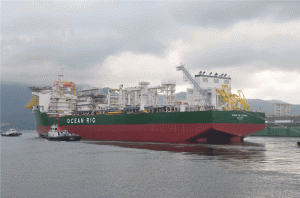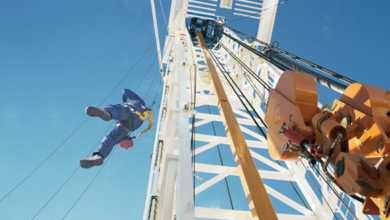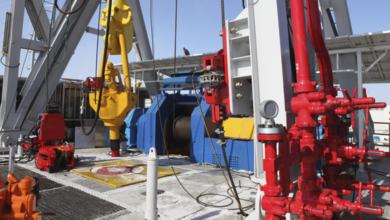Drilling & Completion News
Central GOM lease sale attracts $1.7 billion-plus in high bids
A Central Gulf of Mexico oil and gas lease sale held in June attracted more than $1.7 billion in high bids for tracts on the US Outer Continental Shelf (OCS) offshore Louisiana, Mississippi and Alabama. A total of 56 offshore energy companies submitted 593 bids on 454 tracts covering more than 2.4 billion acres, the US Interior Department announced. The sum of all bids received totaled $2,602,563,726.
The Central Gulf of Mexico Lease Sale 216/222, conducted by the Bureau of Ocean Energy Management (BOEM), offered more than 39 million acres for oil and gas development on the OCS. The acreage included 7,434 tracts from 3 miles to more than 230 miles off the coast, in depths ranging from 10 ft to more than 11,200 ft. BOEM estimates the economically recoverable hydrocarbons that could be produced range from 0.8 to 1.6 billion bbl of oil and 3.3 to 6.6 trillion cu ft of natural gas.
Statoil Gulf of Mexico submitted the highest bid on a tract, at $157,111,000 for Mississippi Canyon, Block 718. Shell submitted the highest total amount in bonus bids, $406,594,560 on 24 tracts. Besides Statoil and Shell, others among the top 10 companies based on the total number of high bids submitted were Apache Corp, BP, Chevron, Apache Deepwater, Stone Energy Offshore, ConocoPhillips, Arena Energy and ExxonMobil.

Songa, Noble to upgrade rig positioning systems
Songa Drilling awarded Nautronix contracts to supply upgrades to NASDrill USBL Transponder digital acoustic positioning systems for two of Songa Drilling’s semisubmersibles, the Songa Venus and Songa Mercur.
Both rigs have been operating with Nautronix analogue RS912 USBL systems since the early ’90s, but the company expects the Nautronix ADS² Digital Acoustics will improve performance and acoustic reliability with the NASDrill USBL system, in operation on the Songa Dee semisubmersible.
Nautronix also has secured another order for their NASDrill RS925 deepwater acoustic positioning system, for Noble Corp’s fourth new ultra-deepwater drillship, under construction at the Hyundai yard in South Korea.
NASDrill RS925 is designed to meet requirements for a stable dynamic positioning and position reference system for offshore operations, in particular deepwater drilling vessels. Nautronix was awarded contracts last year to supply the system for Noble’s previous three new drillships.
Anadarko discovers natural gas, light oil offshore Africa
Anadarko Petroleum has discovered natural gas accumulation within the Offshore Area 1 of the Rovuma Basin offshore Mozambique in June. The Atum discovery well encountered more than 300 net ft (92 meters) of natural gas pay in two high-quality Oligocene fan systems. Preliminary data indicate this latest discovery is connected to the recent Golfinho discovery located approximately 10 miles (16.5 km) to the northwest in the Offshore Area 1.
“We estimate this new complex, which is located entirely within the Offshore Area 1 block, holds 10 to 30-plus Tcf of incremental recoverable natural gas resources,” Bob Daniels, Anadarko senior vice president, worldwide exploration, said.
The Atum exploration well was drilled to a TD of approximately 12,665 ft (3,860 meters), in water depths of approximately 3,285 ft (1,000 meters). Anadarko is the operator in the Offshore Area 1. Co-owners include Mitsui E&P Mozambique, BPRL Ventures Mozambique, Videocon Mozambique Rovuma 1 and Cove Energy Mozambique Rovuma Offshore.
Anadarko also has made a light-oil discovery at the Paon-1X exploration well offshore Cote d’Ivoire. Located in the CI-103 block, the well encountered more than 100 net ft (31 meters) of oil pay. “The Paon well marks the first deepwater discovery in the CI-103 block offshore Cote d’Ivoire and opens up an entirely new play for the country and our partnership,” Mr Daniels said.
Maersk Drilling awards Keppel contract for jackup
Maersk Drilling has awarded Keppel FELS a contract to build a repeat Gusto MSC CJ70 ultra-harsh environment jackup.
Scheduled for delivery in Q1 2015, the rig will be deployed in Dagny field in the Norwegian North Sea for Statoil when completed.
This is the third CJ70 jackup that Keppel FELS is building for Maersk Drilling, following an order for two rigs in February 2011. As part of this repeat order, Maersk Drilling will have an option to build an additional jackup of the same design with Keppel FELS.

Ocean Rig Olympia to continue work in West Africa
Ocean Rig has signed definitive documentation for its ultra-deepwater drillship Ocean Rig Olympia with TOTAL E&P Angola. The contract is for a three-year period for drilling offshore West Africa, with an estimated backlog of approximately USD $652 million. The contract is expected to commence in direct continuation of the rig’s existing contract in West Africa.
TOTAL has the option to extend the contract for two periods of one year each, with the first option exercisable within one year from the commencement date and the second option exercisable within one year after the date of exercise of the first option.
“We are pleased to build on the relationship with TOTAL E&P, which started with the Leiv Eiriksson contract for operations in the North Sea. With five high-specification rigs open in 2013, we are well positioned to leverage the prevalent strong dayrate environment for the deepwater market,” George Economou, chairman & CEO of Ocean Rig, said.
Ensco orders 7th Samsung ultra-deepwater drillship
Ensco has exercised one of two options for an additional advanced-capability DP3 ultra-deepwater drillship based on the Samsung GF12000 hull design. The vessel, ENSCO DS-9, will be the seventh Samsung DP3 drillship in the Ensco fleet. It will be built by Samsung Heavy Industries in South Korea, with delivery scheduled for Q4 2014. Ensco attributed the new order to continued customer demand.
Eni well encounters natural gas offshore Mozambique
Eni recently discovered natural gas in Area 4 of the Rovuma Basin offshore Mozambique at the Coral 1 exploration prospect. The discovery well encountered a total of 246 ft (75 meters) of gas pay in single high-quality Eocene sand, and the Coral discovery is estimated to contain between 7 and 10 Tcf of gas in place, exclusively in Area 4.
BG Group, Statoil make gas discoveries offshore Tanzania
BG Group recently made its fifth-consecutive Tanzania gas discovery with the Mzia-1 exploration well, drilled by Odfjell Drilling’s Deepsea Metro I in Block 1, offshore southern Tanzania.
Preliminary evaluation of the results indicates 180 ft (55 meters) of natural gas pay in good-quality sands. Prior to drilling Mzia-1, the company estimated mean total gross recoverable resources approaching 7 Tcf of gas from the four previous discoveries in Tanzania.
Statoil and partner ExxonMobil also made a large gas discovery in the Statoil-operated Block 2 license in Tanzania in June. The logging results from the Lavani well confirm a new high-impact discovery, with a preliminary resource estimate of 3 Tcf of gas in place.
The Lavani well has encountered 312 ft (95 meters) of excellent-quality reservoir sandstone with high porosity and high permeability. The Lavani well, drilled by Ocean Rig’s Ocean Rig Poseidon in 7,874-ft (2,400-meter) water depth, is the second exploration well in Block 2.
Diamond orders fourth ultra-deepwater drillship
Diamond Offshore Drilling has entered a turnkey contract with Hyundai Heavy Industries for construction of a new ultra-deepwater drillship, with delivery scheduled for Q4 2014. Total cost, including commissioning, spares and project management, is expected to be approximately USD $655 million.
The new drillship, to be named Ocean BlackLion, will be of the same design as Diamond Offshore’s three units currently on order with Hyundai. Design specifications include dynamic positioning, dual-activity capability, a maximum hookload capacity of 1,250 tons and operating capability at water depths up to 12,000 ft. The unit will also feature two seven-ram BOP stacks, with the second available for use as a spare.
Diamond Offshore has elected to equip its previously announced drillships now under construction each with an additional seven-ram BOP to improve rig reliability.
Seadrill secures contract for fully winterized semi
Seadrill has entered a contract with Hyundai Samho Shipyard for the construction of a harsh-environment semisubmersible. The new rig will be a sister rig of a harsh-environment semisubmersible under construction at Jurong Shipyard in Singapore for North Atlantic Drilling, a Seadrill subsidiary.
The new rig will be fully winterized for harsh weather conditions in the North Atlantic and will have ultra-deepwater capabilities to operate in water depths up to 10,000 ft. The rig is scheduled for delivery in Q4 2014.
Marine Well Containment to conduct drill in GOM
US Secretary of the Interior Ken Salazar recently appointed the Marine Well Containment Co (MWCC) to conduct a live drill this summer to deploy well control equipment in the Gulf of Mexico.
The exercise would demonstrate the ability of MWCC to mobilize a capping stack in a timely manner from its onshore base to the deepwater seabed. The Bureau of Safety and Environmental Enforcement (BSEE) will oversee the exercise. The demonstration will involve the deployment and testing of a capping stack as part of a scenario that will also test an operator’s ability to obtain and schedule the deployment of the supporting systems.
BSEE recently participated in an exercise designed to simulate the response to a well blowout in the Chukchi Sea, off the coast of northwest Alaska.
Participants completed an Incident Action Plan, coordinated response efforts, developed response objectives and identified response assets. BSEE will conduct planned and unannounced exercises and inspections through the year to test industry’s ability to meet oil spill response plans and effectively respond to a potential spill in the Arctic.
Recommendations released for E&P of Appalachian Shales
The Appalachian Shale Recommended Practices Group (ASRPG), a consortium of 11 Appalachian Basin natural gas and oil producers, recently created the Recommended Standards and Practices for Exploration and Production of Natural Gas and Oil from Appalachian Shales. The recommendations were developed to promote effective safety, environmental and health practices.
US courts reject challenges to GOM, Arctic development plans
By Katie Mazerov, contributing editor
In what signifies a major victory for the oil and gas industry, two federal appeals courts have shot down environmental challenges to the US government’s approval of development plans in the Gulf of Mexico (GOM) and the Arctic, in effect paving the way for new exploration and drilling activities in the two resource-rich regions.
In a consolidated ruling on 25 May, the Ninth Circuit Court of Appeals in San Francisco upheld an August 2011 decision by the US Bureau of Ocean Energy Management (BOEM) and the Bureau of Safety and Environmental Enforcement (BSEE) to allow Shell to proceed with exploration programs in the Beaufort and Chukchi seas off the North Slope of Alaska. In the ruling, the court dismissed petitions filed by environmental groups challenging the agencies’ approval. The court also had received an amicus brief from several industry and business advocacy groups, including IADC, API, the US Chamber of Commerce and the National Association of Manufacturers, requesting a decision on the matter.
On 30 May, the Fifth Circuit Court of Appeals in New Orleans dismissed a petition filed by the Sierra Club, the Gulf Restoration Network and the Center for Biological Diversity, all nonprofit environmental organizations, claiming that the US Department of Interior’s (DOI) approval of 16 GOM drilling plans violated the Outer Continental Shelf Lands Act (OCSLA) and the National Environmental Policy Act (NEPA) of 1969. The petitioners had argued that the DOI’s 2010 approval of 16 drilling plans violated OCSLA because it failed to consider the Macondo incident in approving further deepwater drilling and that the agency conducted an inadequate review of the plans under NEPA because it incorrectly applied “categorical” exclusions from NEPA requirements to those plans.
But the court concluded that four of the OCSLA-based challenges were moot, and dismissed the remaining challenges because of the petitioners’ failure to participate in the required administrative proceedings. “These decisions demonstrate the regulatory community’s faith in the industry’s ability to carry out offshore exploration and drilling activities that are safe and environmentally responsible,” said IADC president and CEO Stephen Colville. “The significance of these two important regions to the US government, energy consumers and the industry cannot be underestimated as we strive to meet increasing global demand for hydrocarbons.”
IADC chairman Dan Rabun, Ensco chairman, president and CEO, echoed that sentiment, noting that the dual rulings could be a significant turning point for offshore production. “This is very positive news for drilling contractors,” he said. “We look forward to ramping up activity in these key areas.”
A decade-old issue
The Arctic ruling marked the culmination of a decade-old case that began when the former Minerals Management Service (MMS) established a five-year lease sale schedule for the outer continental shelf of Alaska. Several environmental groups filed a court challenge to the MMS’ 2007 approval of Shell’s exploration plan for the Beaufort Sea, a petition that was upheld by the Ninth Circuit Appeals Court. Shell’s revised plan was approved by MMS and upheld by the court.
Following the Macondo incident and the ensuing drilling moratorium, Shell in August 2011 submitted new exploration plans for the Beaufort and Chukchi seas to the new BOEM and an oil spill response plan to BSEE. The approvals were again challenged in court by several environmental groups, including the Alaska Wilderness League, the Native Village of Point Hope, Greenpeace, the Sierra Club and the National Audubon Society, among others, claiming the plan failed to comply with OCSLA requirements and lacked adequate oil-spill response and well-capping measures.
The court, however, ruled in favor of the government, stating that the plans did in fact include adequate safety measures and complied with OCSLA requirements.



